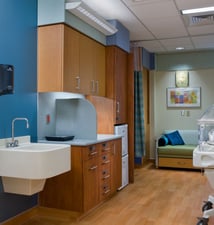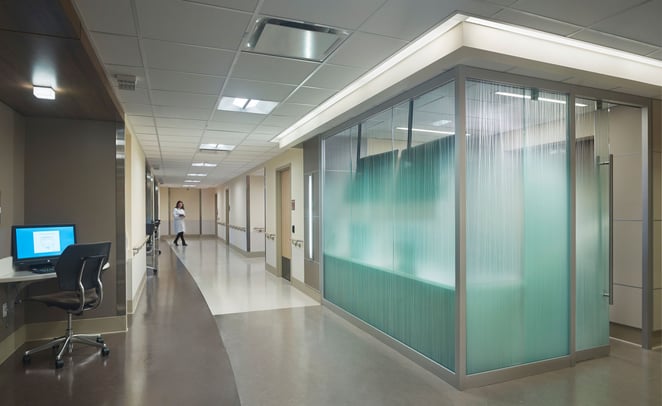As mentioned in Part I of my Pediatric Patient Room of the Future blog, the patient and their families, as well as the potential of rapidly-changing technology, dictates that flexibility in all aspects of planning and design be at the forefront of every endeavor. In this blog, I will focus on Safety & Infection Control and the Healing Environment.
Safety and Infection Control:
Building systems must take into consideration the importance of acoustics and air quality. Noise is not only a source of patient/family dissatisfaction, it has the ability to disrupt recovery and impede communication. Sound absorbing materials should be specified, and proper location of mechanical components can minimize noise and vibration on patient units. Additionally, air quality and system maintenance should reflect any unique requirements of the patient population, such as asthma and allergies. Location of both handwashing sinks and gel should be accessible upon entering the unit and patient room, with separate sinks for handwashing, equipment cleaning, etc. The design team should carefully evaluate the sink design, location and spray aeration.
Location of both handwashing sinks and gel should be accessible upon entering the unit and patient room, with separate sinks for handwashing, equipment cleaning, etc. The design team should carefully evaluate the sink design, location and spray aeration.
Materials and design should be maintainable with joints and horizontal surfaces minimized. Additionally, designers should consider anti-microbial products; sustainable, green or non-toxic materials; and room-cleaning technologies.
Health systems must evaluate positive distractions, such as aquariums and plantings, based on the patient population. If deemed appropriate for the space, positive distractions can be designed to minimize risk.
Healing Environment:
All of the identified considerations contribute to the creation of a healing environment. One in which patient recovery is paramount; senses are engaged; patients and families are empowered and have control; positive distractions (art, views, outdoor access) are available for patients and families; and there is social support with environmental stressors minimized for a safe and secure pediatric unit.
The pediatric inpatient unit of the future must provide high quality, high-tech care in an uplifting, inspirational and safe environment. The architectural and interior design influences the overall environment from a patient, family and clinician point of view. The patients and families benefit from thoughtfully designed interior elements created for the specific pediatric population. Clinicians in these fast-paced, high-stress environments should have appropriate on-unit charting, and a team center space with design elements that benefit the unit as a whole.


